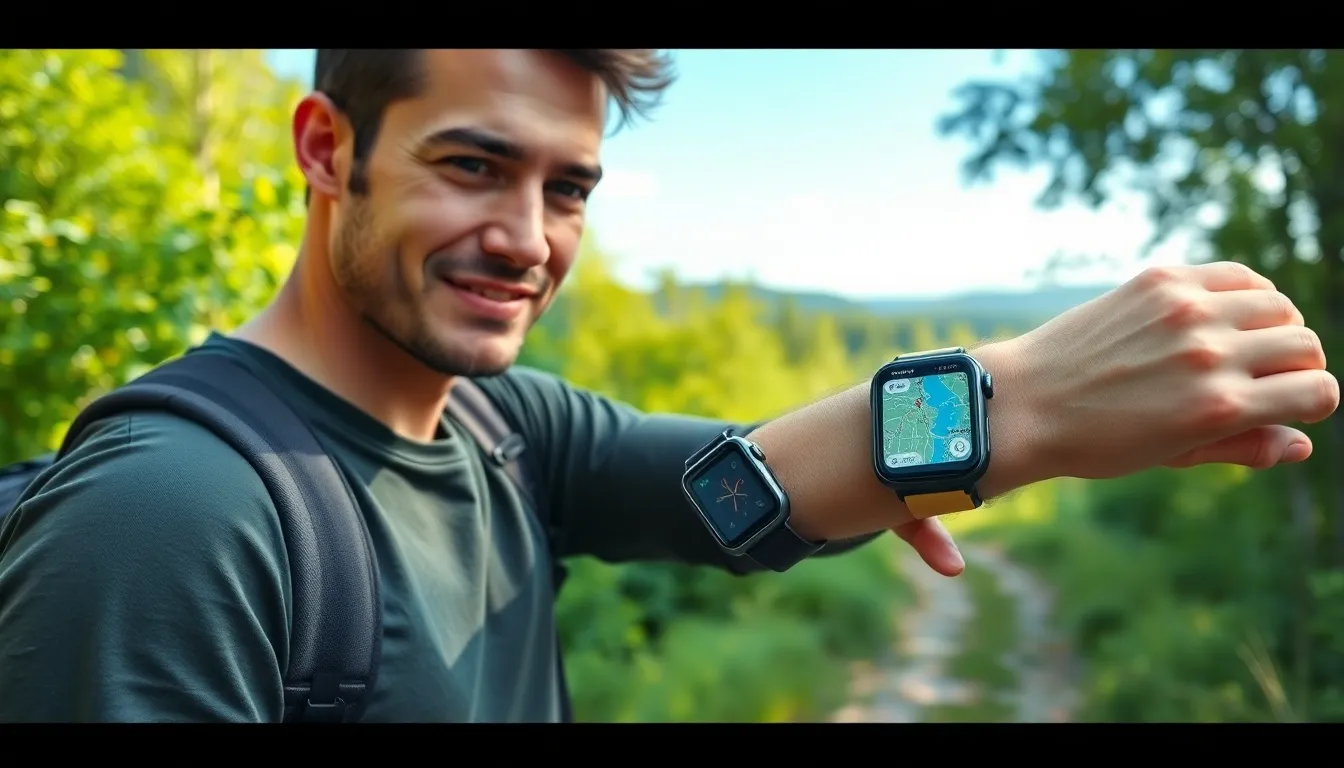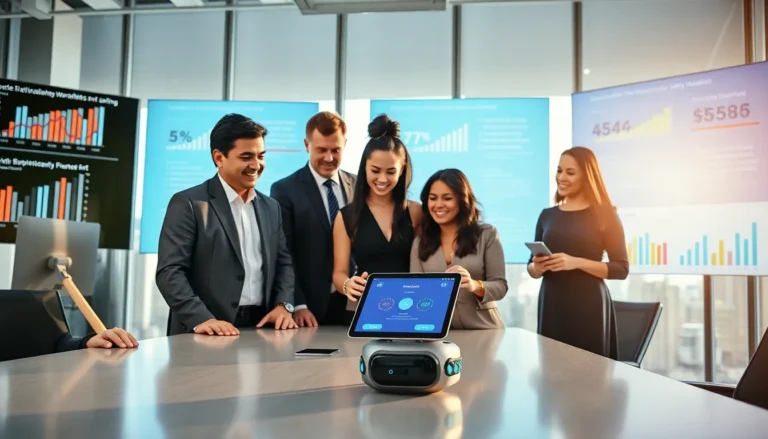Table of Contents
TogglePicture this: you’re wandering through a bustling city, trying to find that hidden gem of a coffee shop, but your phone’s navigation app keeps insisting you take a left into a fountain. Enter wearable navigation—your stylish sidekick that won’t steer you wrong. These nifty gadgets are designed to guide you seamlessly, whether you’re on a hike, exploring a new city, or just trying to avoid that awkward encounter with your ex.
Gone are the days of fumbling with phones while dodging pedestrians. With wearable navigation, you can keep your hands free and your eyes on the prize. These devices not only provide real-time directions but also add a dash of tech-savvy flair to your outfit. So why not embrace the future? Buckle up (or rather, strap on) and get ready to navigate like a pro, all while looking effortlessly cool.
Overview of Wearable Navigation
Wearable navigation devices enhance exploration by providing hands-free guidance. Users appreciate the convenience of receiving real-time directions through smartwatches, glasses, or other wearables. These devices use GPS and other technologies to deliver accurate navigation data right on the user’s wrist or display.
Wearable navigation is particularly beneficial for activities like hiking or biking. During these activities, users can focus on their surroundings while enjoying the route. Additionally, wearable devices often feature voice prompts, making it easier to follow directions without diverting attention from the environment.
Several brands have entered the market, offering unique features. Smartwatches from Garmin, Apple, and Fitbit lead in functionality and style. Enhanced user interfaces on these devices make navigation effortless, appealing to both casual and serious travelers.
Functionality extends beyond simple navigation. Many wearable devices include fitness tracking and health monitoring features. Data about distance traveled, heart rate, and calories burned provide users with valuable insights into their activities.
Experts predict the growth of wearable navigation technology. Rising interest in smart wearable devices coincides with advancements in navigation software. Innovative features like augmented reality are being incorporated into navigation systems, making the experience immersive.
This combination of style and functionality makes wearable navigation devices an attractive choice for modern explorers. With increasing capabilities, these gadgets not only guide users through their journeys but also elevate their overall experience.
Types of Wearable Navigation Devices

Wearable navigation devices come in various forms, each designed to cater to specific user needs. Understanding these types helps users choose the right device for their adventures.
Smartwatches
Smartwatches serve as multifunctional devices that combine navigation and communication. These gadgets utilize GPS technology to provide real-time directions while syncing with smartphones. Most smartwatches include fitness tracking capabilities, allowing users to monitor their health metrics during outdoor activities. Popular models, like the Apple Watch and Garmin Forerunner, feature intuitive interfaces that display maps and provide haptic feedback for navigation alerts. The appeal also lies in their stylish designs, making them suitable for daily wear and exercise alike.
Fitness Trackers
Fitness trackers focus on health monitoring but also include navigation features. Devices from brands like Fitbit and Garmin allow users to follow pre-planned routes while tracking distance, pace, and elevation. These wearables typically offer built-in GPS, ensuring users receive accurate location data without relying on smartphones. They also sync with various fitness apps, enhancing the user’s workout experience. By combining navigation and fitness tracking, these devices appeal to active individuals looking for versatile tools to optimize their adventures.
AR Glasses
AR glasses represent an innovative approach to wearable navigation, blending digital information with the real world. Devices like Google Glass and Nreal Light overlay navigation prompts onto a user’s field of view. These glasses allow users to stay aware of their surroundings while receiving turn-by-turn directions. Incorporating voice assistance enhances the hands-free experience, making navigation safer during activities like cycling or walking. AR glasses not only improve navigation but also create immersive experiences, offering users a futuristic way to explore their environments.
Key Features and Technologies
Wearable navigation devices incorporate advanced technologies that enhance the user experience. Each feature plays a vital role in ensuring users can navigate effortlessly and stylishly.
GPS and Geolocation
GPS technology serves as the backbone of wearable navigation. Accurate geolocation enables users to access real-time positioning and directions, greatly enhancing outdoor adventures. Many devices utilize satellite signals for precise tracking, making navigation seamless during hikes or city exploration. Users benefit from the ability to follow custom routes, whether they choose fitness paths or scenic tours. Enhanced mapping features allow for efficient plan adjustments, ensuring a smooth journey toward any destination.
Connectivity Options
Connectivity serves a crucial function in wearable navigation. Bluetooth, Wi-Fi, and cellular connections enable devices to sync with smartphones and access updated maps. Such connections facilitate streamlined communication and app integration, offering a richer user experience. Users can receive notifications and updates without needing to check their mobiles. Multiple connectivity options provide flexibility in how users interact with their navigation devices, enhancing convenience during travel.
User Interface Design
User interface design significantly impacts usability in wearable navigation devices. Intuitive layouts ensure users can access navigation features quickly and easily. Touchscreens, voice commands, and gesture controls enhance interaction, making it simple to follow directions or adjust settings on the go. Visual clarity plays a key role, as clean graphics and contrasting colors help users read maps and prompts effectively. Additionally, customization options allow users to tailor interfaces based on personal preferences, ensuring a seamless experience in various environments.
Benefits of Wearable Navigation
Wearable navigation devices offer several significant advantages for users seeking convenience, safety, and accessibility while navigating their surroundings.
Increased Convenience
Users enjoy unmatched convenience with wearable navigation devices. These gadgets allow for hands-free operation, enabling individuals to focus on their environment while seamlessly receiving directions. Smartwatches and fitness trackers provide notifications without interrupting activities, like hiking or cycling. Voice prompts enhance usability, making it easier to follow routes without needing to glance at a phone. Popular brands such as Garmin and Apple integrate features that streamline navigation, ensuring users stay oriented and engaged. Furthermore, these devices often come with customizable settings, allowing users to tailor notifications and alerts according to personal preferences.
Enhanced Safety
Wearable navigation devices significantly enhance user safety during outdoor activities. Attaching GPS technology to the wrist or eyewear means individuals can navigate without distractions. While walking or biking, users stay aware of their surroundings, reducing the likelihood of accidents. Real-time updates on traffic, weather, or hazards help users make better-informed decisions. Certain smartwatches even allow for emergency alerts. This feature can contact emergency services if needed, allowing for quicker responses when emergencies arise. Overall, wearables promote safe exploration by keeping essential navigation data easily accessible and unobtrusive.
Improved Accessibility
Improved accessibility characterizes wearable navigation devices, making them inclusive for a wider user base. These gadgets often feature voice recognition capabilities, catering to users with visual impairments. Customizable interfaces allow for various fonts, colors, and sizes. Users can adjust these settings according to their visual preferences, ensuring ease of navigation. Furthermore, the lightweight and compact design of wearables means that they suit diverse lifestyles, whether for fitness enthusiasts or casual users. As technology evolves, new developments promise to enhance accessibility even further, fostering an inclusive environment for all explorers.
Challenges and Limitations
Wearable navigation devices face several challenges and limitations that impact their usability and user experience.
Battery Life Concerns
Battery life poses a significant challenge, especially during extended outdoor activities. Many wearable navigation devices require frequent charging, which can interrupt usage when users rely heavily on them. Smartwatches and fitness trackers typically last between 24 to 48 hours on a single charge, with GPS usage draining power even faster. Users should consider the trade-off between features and battery longevity when selecting a device. Some models incorporate battery-saving modes, yet they may limit functionality. Seeking brands with optimized battery performance becomes crucial for those who spend long periods navigating.
Privacy Issues
Privacy issues present another critical challenge for wearable navigation technology. Many devices track user location and collect data, raising concerns about unauthorized data access. Users might unknowingly share their location with third parties through apps and services enabled on wearables. Implementing robust security measures becomes essential for manufacturers to protect user data effectively. Users often face risks of being tracked in real-time without their consent. Prioritizing devices with strong privacy policies can mitigate these concerns while still allowing users to enjoy the advantages of wearable navigation.
Future of Wearable Navigation
The future of wearable navigation looks promising, with advancements shaping an exciting landscape for users.
Emerging Trends
Manufacturers prioritize seamless integration with everyday life. Smartwatches and augmented reality glasses gain popularity due to their multifunctionality. User experience customization becomes essential, allowing individuals to tailor features to their preferences. Enhanced voice recognition technology is on the rise, making navigation even more intuitive. As urban environments evolve, the demand for real-time updates increases, allowing wearables to guide users through dynamic cityscapes. Sustainability also becomes a trend, with eco-friendly materials being incorporated into designs. Alongside these developments, wearable navigation devices enhance their role in fitness through improved metrics and analytics, catering to an active lifestyle.
Potential Innovations
Innovative features are set to transform user experiences. AI algorithms promise smarter route suggestions, adapting to user behavior and preferences over time. Incorporating augmented reality presents an opportunity to overlay real-time navigation prompts onto surroundings, enriching user interaction. Improved battery technology aims to extend device life significantly, reducing concerns about charging frequency. Additionally, incorporating biometric sensors into wearables could provide personalized feedback during navigation. Integration with smart home devices may enhance users’ overall navigation experience, creating a more connected and responsive ecosystem. These potential innovations combine to create a future where wearable navigation significantly enriches the way individuals explore their environments.
Wearable navigation devices are revolutionizing how people explore their surroundings. By offering hands-free guidance and stylish designs, these gadgets enhance the overall experience of outdoor activities. With advancements in technology and user-focused features, they provide not only accurate navigation but also valuable health insights.
As the market continues to evolve, users can expect even more innovative functionalities that cater to their needs. Embracing this technology allows for a seamless blend of convenience and style, making every journey more enjoyable. Awareness of potential challenges, such as battery life and privacy concerns, remains essential. Ultimately, wearable navigation devices represent a significant step forward in how individuals navigate the world around them.




